
The DFV is an internal combustion engine that was originally produced by Cosworth for Formula One motor racing. The name is an abbreviation of Double Four Valve, the engine being a V8 development of the earlier four-cylinder FVA, which had four valves per cylinder.
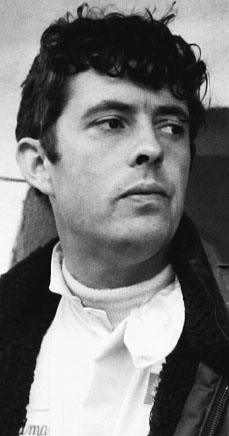
Brian Herman Thomas Redman, is a retired British racing driver.

The Mirage Lightweight Racing Car was a family of race cars built by J.W. Automotive Engineereing (JWAE) at Slough in England, initially to compete in international sports car races in the colours of the Gulf Oil Corporation.
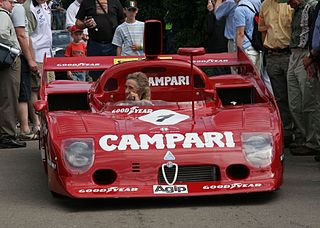
The Alfa Romeo Tipo 33 was a sports racing prototype raced by the Alfa Romeo factory-backed team between 1967 and 1977. These cars took part for Sport Cars World Championship, Nordic Challenge Cup, Interserie and CanAm series. A small number of road going cars were derived from it in 1967, called Alfa Romeo 33 Stradale.

The 1983 24 Hours of Le Mans was a motor race staged at the Circuit de la Sarthe, Le Mans, France on 18 and 19 June 1983. It was the 51st Grand Prix of Endurance and was also the fourth round of both the 1983 World Endurance Championship and the 1983 European Endurance Championship. The 1983 race was held eight days before the 50th anniversary of the inaugural race held in 1923.

The 1982 24 Hours of Le Mans was the 50th Grand Prix of Endurance, which took place on 19 and 20 June 1982. It was also the fourth round of the 1982 World Endurance Championship. As well as a significant anniversary, this was a watershed year for Le Mans, with the highly anticipated advent of the FIA's Group C regulations, the essence of which was to allow an open engine formula but a minimum weight for safety and a proscribed fuel allocation.

The 1981 24 Hours of Le Mans was the 49th Grand Prix of Endurance, and took place on 13 and 14 June 1981. It was also the eighth round of the World Endurance Championship of Drivers, and the fifth round of the World Championship for Makes.

The 1980 24 Hours of Le Mans was the 48th Grand Prix of Endurance, and took place on 14 and 15 June 1980. It was the seventh round of both the World Championship for Makes and World Challenge for Endurance Drivers. With neither the Porsche nor Renault works teams contesting the big Group 6 sports-cars for outright victory, it left the prospects open for a privateer victory from Joest, Rondeau or De Cadenet, or from Group 5 again, if they were to fail. The wet weather throughout the race further added to the uncertainty, reducing the advantage of the more powerful cars.

The 1979 24 Hours of Le Mans was the 47th Grand Prix of Endurance, and took place on 9 and 10 June 1979. With no other major works cars this year, the Porsche team were the strong favourites to win. Their competition would be from Cosworth-powered Mirages and Rondeaus and a swarm of Group 5 and IMSA-class Porsche 935s. The other big talking point was the presence of Hollywood actor Paul Newman, driving for Dick Barbour Racing.
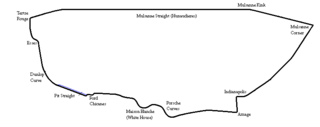
The 1978 24 Hours of Le Mans was the 46th Grand Prix of Endurance, and took place on 10 and 11 June 1978. In many ways it was a continuation of the race from the year before – the two main protagonists would be the very evenly-matched works teams of Alpine-Renault and Porsche, with four cars each. The race was not valid for any championship.

The 1976 24 Hours of Le Mans was the 44th Grand Prix of Endurance, and took place on 12 and 13 June 1976. This year the FIA introduced its new Group 5 and Group 6 regulations and the race was now open to nine distinct classes, although it was still not part of the World Championship seasons. Porsche introduced its new models, the 936 in Group 6, the 935 in Group 5 and the 934 in Group 4. In response, BMW had its modified 3.0 CSL in Group 5. It was the year that turbos arrived in considerable numbers, with over a dozen turbocharged entries, led by the Renault Alpine A442. It saw the arrival of French prototype manufacturers Jean Rondeau and Gérard Welter in a new GTP class and a first-time invitation to American IMSA and NASCAR entries.

Jean Rondeau was a French race car driver and constructor, who won the 24 Hours of Le Mans in 1980, in a car bearing his own name, an achievement which remains unique in the history of the race.

The Sauber SHS C6 was a Group C prototype racing car built by Swiss manufacturer Sauber and engineering firm Seger & Hoffman, intended for competition in the World Endurance Championship and Deutsche Rennsport Meisterschaft series. Seger & Hoffman left the project later in 1982, leaving the car completely under Sauber's control.

João Ricardo da Silva Coelho Barbosa is a Portuguese auto racing driver. He currently competes in the IMSA WeatherTech SportsCar Championship for Sean Creech Motorsport in the LMP3 class.
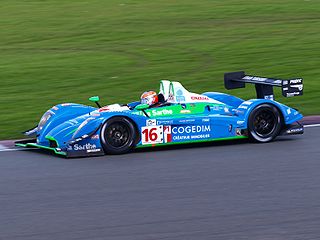
The Pescarolo 01 was the first sports prototype racing car built entirely by French team Pescarolo Sport. It had been designed to meet the LMP1 and LMP2 regulations for Le Mans Prototypes in the Le Mans Series as well as at the 24 Hours of Le Mans, and replace Pescarolo's previous C60 chassis which had been heavily modified from cars purchased through Courage Compétition. The 01s debut was at the 2007 1000 km of Monza.
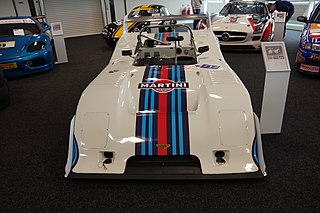
The Chevron B31 was a sports prototype racing car built by Chevron Cars Ltd in 1975, and initially used in the European 2-Litre Championship. The car was an evolution of the Chevron B26, and was initially fitted with a 2-litre Hart 420R straight-four engine producing 290 hp. However, various other engines were used; the car also ran with engines such as the 3-litre Cosworth DFV V8, the 2-litre Cosworth FVD/Cosworth BDG straight-four engines, and the 2-litre BMW M12 straight-four, amongst others.
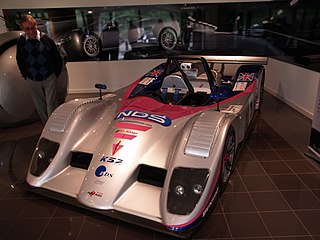
The Ascari A410 was a Le Mans Prototype built by Ascari Cars in 2000. The car, which was based on the Lola T92/10 Group C racing car, featured a 4-litre Judd GV4 V10 engine, and was used in European and international sports car racing events. In 2002, it was renamed as the Ascari KZR-1.
The Matra MS620 was a Group 6 sports prototype built by Matra in 1966, and was the second such car built by the company. Fitted with a 1.9 litre version of the BRM Formula One V8 engine, four cars were built, but were mostly used as developmental cars. In 1967, the MS620 was replaced by the 3 litre Matra MS630, although it was used in the Le Mans Test of that year, fitted with a 4.7 litre Ford V8 engine.
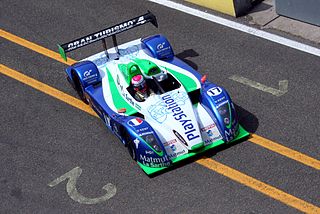
The Courage C60 was a Le Mans Prototype (LMP) racing car built by Courage Compétition in 2000, and used in international sports car races until 2006. A replacement for the Courage C52, it was Courage's first all-new prototype since the Courage C41 was built in 1994.

The Rondeau M482 was a Group C sports car prototype, designed, developed and built by Automobiles Jean Rondeau in 1982, and used in sports car racing until 1987.


















